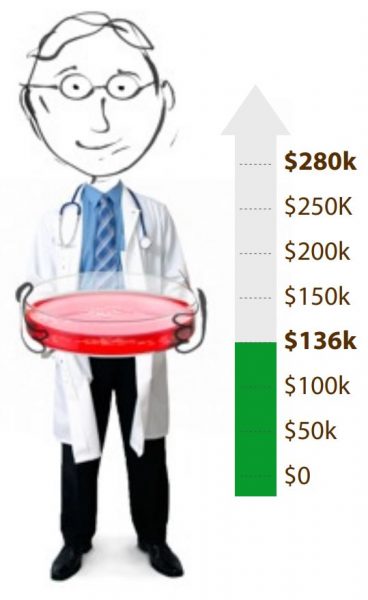Bedford Research Foundation 2010 Newsletter
Read about all of the progress and the research that has occurred at the Foundation over the course of the past year! Dr. Kiessling outlines her vision for the upcoming year as well. Thank you for your support.
The Testis: a source of stem cells for all men?
Could the newly discovered “testis stem cells” be as versatile as embryonic stem cells? Bedford is launching a major research initiative to find out.
A major barrier to progress in stem cell therapies is that, similar to organ transplantation, the body rejects cells that are not a good match for the patient. Surprisingly, stem cells from testis may offer a solution. In 2008, a German team reported that they successfully derived pluripotent stem cells from adult mouse testis. Because of their unique ability to become any type of cell in the body, pluripotent stem cells hold the promise of cures to many conditions, from diabetes to spinal cord diseases. Then in 2009, two U.S. research teams discovered pluripotent stem cells in human testis.
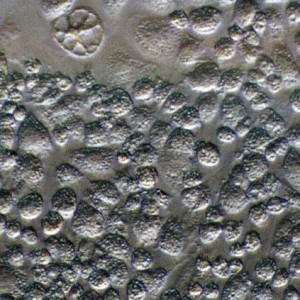 If pluripotent stem cells can be derived from every human testis, it could launch a new era in stem cell research.
If pluripotent stem cells can be derived from every human testis, it could launch a new era in stem cell research.
Stem cells derived from human testis could help overcome two of the biggest barriers to stem cell therapies. First, these cells could avoid the controversies of using human eggs and embryos for research. Second, these cells could solve the need for patient-specific stem cells to avoid the rejection that occurs if transferred cells are not a perfect tissue match to the patient’s own cells.
Dr. Martin Dym’s research team at Georgetown University estimates approximately 1 in 100,000 testis stem cells may be pluripotent. For several decades, it has been known that sperm are abundantly produced (billions per week) in the adult male testis for life, and that the sperm arise from “sperm stem cells” termed spermatogonia. However, the new reports indicate that in addition to the spermatogonia, there are pluripotent stem cells in the testis. To follow up these exciting reports, Bedford Research scientists have launched a new research initiative to answer several important questions: (1) Can stem cells be derived from the testis of all men? (2) How stable are the testis stem cells in long term culture? (3) Can they prove useful to treat spinal cord diseases, such as injury, amyotrophic lateral sclerosis, and multiple sclerosis? (4) Can they prove useful to cure HIV disease?
Help Us Reach Our Goal
As of November 2010, the Foundation has raised $136,000 towards this project. We need $280,000 to get started, and a total of $550,000 to complete the twoyear study. Please help us meet our goal to pursue this promising research – visit: www.bedfordresearch.org
The 2010 Activated Egg Symposium
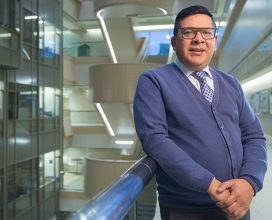
Nov 5, 2010: The eighth annual symposium will be co-hosted by Dr. Ann Kiessling and Dr. Gary Stein, University of Massachusetts Medical School. The 2010 keynote will be Dr. Ivar Mendez, Head of Neurosurgery, Dalhousie University, Halifax, Nova Scotia, Canada. Dr. Mendez will speak on the new methods he is developing for delivering stem cells to the brain and the spinal cord. The dinner speaker will be Dr. Ed Wirth, Geron Corp., who will speak on the first FDA approved clinical trial for stem cell therapy. The trial’s focus is acute spinal cord injury. Hamilton Thorne is proud to help sponsor the 2010 Symposium.
New Steps Toward a Stem Cell Cure for HIV: Promising Treatment
March, 2009: A proof of-concept report from German scientists demonstrated that HIV-infected cells could be eliminated from the body using bone-marrow transplantation. At the time of this report, it seemed unlikely that sufficient bone marrow would be available for these types of transplants. But now, developments in stem cell science may have changed that:
First, the possibility of deriving stem cells that are patient-specific, e.g. from testis (see front page) will eliminate the need to use bone marrow cells from bone marrow banks.
Second, the methods for developing bone marrow cells from pluripotent stem cells have greatly advanced in the past two years.
Third, the method for silencing specific genes in human cells (a step necessary to block the HIV receptor) has also greatly advanced in the past two years.
Taken together, it is now theoretically possible for scientists to develop and test this method within 5 to 8 years.
Workshop in Taiwan
 April, 2010, BSCRF co-sponsored the International Conference of Stem Cells and Regenerative Medicine for Neurodegenerative Diseases at the Tzu Chi Medical Center in Taiwan.
April, 2010, BSCRF co-sponsored the International Conference of Stem Cells and Regenerative Medicine for Neurodegenerative Diseases at the Tzu Chi Medical Center in Taiwan.
Research & Therapy in Practice
Foundation scientists and visiting guests took a rare look inside Taiwan’s premiere stem cell institute and shared research and best practices.
Over 20 talks were given by surgeons, basic researchers and neuroscientists. (videos at SpinalCordWorkshop.org) The goal of the meeting, as in past Bedford Spinal Cord Workshops, was to share vital information across disciplines and to discuss the barriers to curing spinal cord injury. Dr. Ed Wirth, Geron Corporation, reported on progress in the first U.S. Food and Drug Administration approved trial for stem cell therapy on acute spinal cord injury. Dr. Wise Young reported on progress in similar trials planned for China and the U.S.
Universal Barriers to Cure
The conference wrapped-up with a Round Table Discussion & Concluding Remarks, moderated by Dr. Ann A. Kiessling, Dr. Wise Young and, Dr. TzuYung Chen. In addition to funding needs, the group described the need for appropriate regulatory guidelines that both protect patients and allow the work to go forward as quickly as possible in most countries, including India, Japan, China, Canada and the U.S.
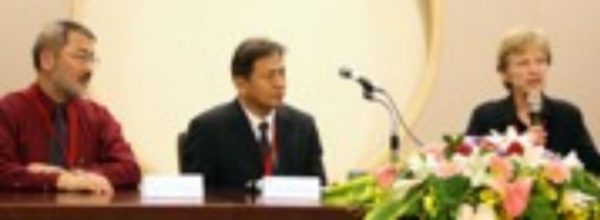
Dr. Ann A. Kiessling, Dr. Wise Young and, Dr. TzuYung Chen moderated the lively discussion between surgeons and basic scientists
Foundation Publication
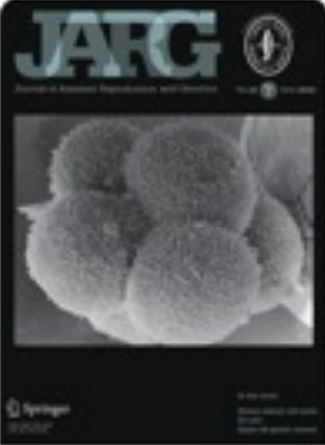 Circadian Rhythms and Cell Division
Circadian Rhythms and Cell Division
June, 2010: The second report by Bedford scientists about cell division appeared, as the cover story of the JOURNAL OF ASSISTED REPRODUCTION AND GENETICS. The work builds on the previous report of CLOCK genes that indicate early stem cells may be under the control of circadian rhythms (see report at bedfordresearch.org). These novel findings about controls on cell multiplication will be used in the derivation of testis stem cells to attempt to improve the efficiency and stability of new stem cell lines.
Studies launched to detect genes expressed by men with prostate cancer
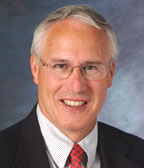
Robert Eyre, MD
October, 2010: Dr. Robert Eyre presented recent prostate cancer work by BedfordFoundation Scientists at the New England chapter of the American Urologic Association. Dr. Eyre has studied diseases of the male genitourinary tract with Bedford Research scientists for over 20 years.
The current work is focused on developing improved early detection tests for prostate cancer by taking advantage of technology developed to detect infectious diseases in semen, such as HIV and bacteria. Applying whole genome microarrays, Drs. Kiessling and Eyre have launched studies to detect which genes are over-expressed or under-expressed in semen specimens from men with and without prostate cancer.
The recent work identified 6 genes under-detected and 9 genes overdetected in cancer semen specimens. The research needs to be confirmed in a larger series of study subjects.
Gabbay Award
Dr. Ann Kiessling received the Gabbay award in Biotechnology and Medicine in November 2009 along with Dr. Gianpero Palermo and Dr. Alan Handyside. The award highlights Dr. Kiessling’s nearly 3 decades of research in assisting infertile couples, most recently those living with HIV disease. Learn more at: www.sementesting.org
2010 ISSCR
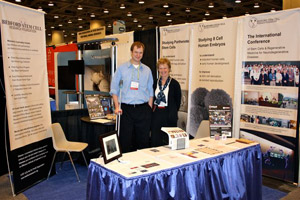 June, 2010: Bedford Research Foundation sponsored a booth at the annual meeting of the International Society of Stem Cell Research in San Francisco. The booth attracted many visitors to its information about parthenote stem cells, testis stem cells, circadian control of the cell cycle, and other Bedford Research programs.
June, 2010: Bedford Research Foundation sponsored a booth at the annual meeting of the International Society of Stem Cell Research in San Francisco. The booth attracted many visitors to its information about parthenote stem cells, testis stem cells, circadian control of the cell cycle, and other Bedford Research programs.
Q & A
With the Director About Stem Cell Research at the Foundation
Q: Has Obama’s Policy Helped Fund Stem Cell Research?
A: President Obama’s executive order to rescind the restrictions on the number of stem cell lines that could be studied with federal funds was valuable for some studies, but as long as the Dickey-Wicker amendment controls federal funds, the development of stem cells from unfertilized eggs, a prime goal of Bedford Research scientists, cannot be federally funded.
Q: Why do patients need their own stem cells?
A: The clinical trials that have provided “proof-of-principle” for cell-based therapies, e.g. transplantation of pancreatic cells for diabetes, have revealed that although some cells function normally, many fail because the transferred cels are rejected as “foreign.” The same is true for transplanted bone marrow in cancer therapies. If the stem cells were the patient’s own (i.e. patient-specific), they would not be rejected.
Q: Why do Bedford scientists work with parthenote and testis stem cells?
A: Parthenote stem cells are derived from unfertilized human eggs, not embryos. Parthenote stem cells behave like embryonic stem cells in the laboratory, multiplying to the trillions needed for therapy, either for the egg donor herself, or for tissue-matched patients. Testis stem cells offer the possibility of deriving stem cells for every man in need, if they can be encouraged to multiply to the trillions possible with parthenote stem cells.
Q: How does Bedford Stem Cell Research Foundation fund its research?
A: By private donations. The Foundation’s licensed clinical laboratory conducts highly specialized fee-for-service tests which cover the costs of the laboratory infrastructure. This allows research activities to proceed with minimal overhead. The lack of dependence on federal dollars also frees the Foundation from the administrative costs of separate accounting practices required by the Dickey-Wicker amendment.
Who is Bedford Research Foundation?
Philanthropy Is The Key To Continued Progress
The average cost of each experiment is $90,000. Because much of our overhead is covered by fee-for-service laboratory tests, 92% of every dollar donated goes directly toward these experiments. This innovative funding model allows Bedford Research scientists greater flexibility to move quickly in promising new research directions.
Continued progress requires meeting our annual funding goal of $450,000 in 2019.

